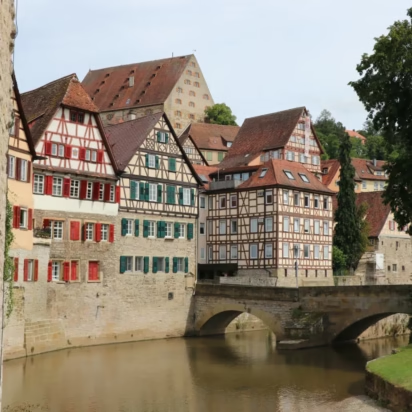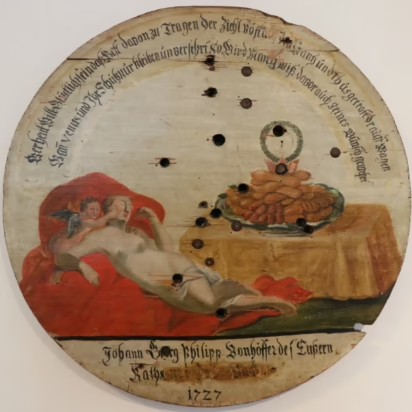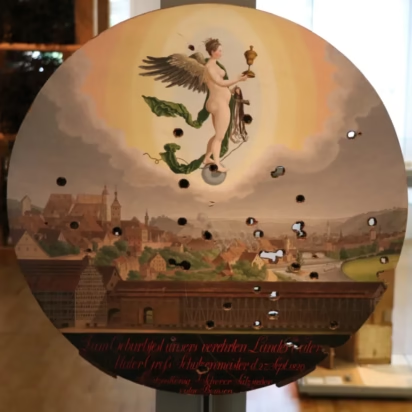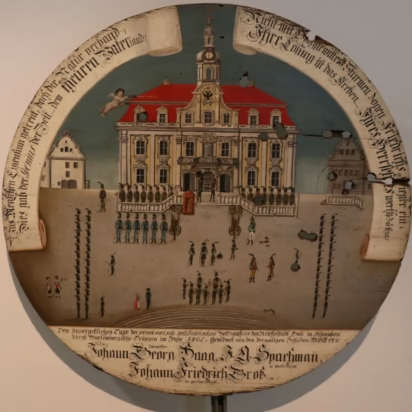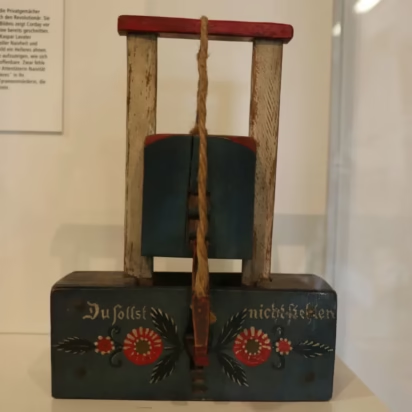The Hällisch-Fränkisches Museum in Schwäbisch Hall in southern Germany is a free and fun local history museum to visit.

Schwäbisch Hall is a picture-perfect German town in Baden-Württemberg complete with many half-timbered houses, a large Gothic church in front of a market square with cafes, a modern art museum, and a river flowing through it. It has an interesting history but of no real significance making the local history museum a pleasure to visit. The Hällisch-Fränkisches Museum in Schwäbisch Hall covers the history of the town (Hällisch) as well as the immediate Franconia (Fränkisches) area in a fascinating display that is easy to enjoy, whether closely studying the exhibits or simply strolling through to glance at the main items. The wood paneling of a synagogue painted in 1738 is probably the most important art in the museum but many items are worth seeing. Admission is free.
Permanent Exhibition of the Hällisch-Fränkisches Museum
Although the permanent exhibition of the Hällisch-Fränkisches Museum Schwäbisch Hall is spread over seven buildings, in effect the museum is easier split into two sections: the Keckenburg Tower that covers prehistory to 1802 and the Stadtmühle (City Mill) that covers 1802 to the present.
The museum entrance is in a modern building that gives direct access to the rest of the museum.
Don’t be put off by the claim that its exhibition space of over 3000 m2 spread over seven buildings make it one of the largest museums in Baden-Württemberg. Inside it hardly feels big and it is easy to move on quickly if desired.
Museum Exhibition in the Keckenturm in Schwäbisch Hall

The Keckenturm is the easiest part of the museum to enjoy. The stone tower dates back to 1240 while the half-timbered upper floors were added in 1508. Rooms are relatively small so there is constant movement to change floors and discover something new. This part of the museum is without an elevator.
The exhibition starts with a model of Schwäbisch Hall before a major town fire in 1728. A shield from 1516 show the town symbols — Hall was a free imperial city from 1280 but the imperial eagle was literally knocked off this shield sometime after 1802 when the city became part of the Duchy of Württemberg (which also explains why the exhibition in this building stops exactly in 1802 and not in 1800).
To follow the chronology, go down to the basement where the prehistory, early history, and geology are briefly covered. Here are also a few torture implements and a reconstruction of a historic crane to show how easy it is to lift a heavy load with the right equipment. (The Medieval Crime Justice Museum in nearby Rothenburg ob der Tauber is the best museum in Germany to cover the medieval legal system and torture instruments)
The best art pieces surviving from the Middle Ages are invariably religious items from churches and cloisters and the exhibition here is no exception. Note the Pieta carved in Swabia around 1350. It probably survived this well as it was banished to the attic of St Michael’s during the Reformation, which was accepted in Hall in 1522. The altar retable from the church in Rieden is an artistic highlight although the two sculptures of Christ on the donkeys from the 15th century often get more attention.
Early Modern History in the Schwäbisch Hall Museum
The German sculptor Leonhard Kern (1588-1662) worked in Schwäbisch Hall during the Thirty Years War (1618-48) and a few of his smaller works are on display.
The Barocksaal (Barock Room) survived from around 1730 with stucco, a large central ceiling painting of musicians, and corner medallions of the other senses.
A whole floor is dedicated to the museum’s collection of around 200 painted target shooting shields (Bemalten Schützenscheiben) — the largest collection in Europe. The oldest is from 1727 — older ones were presumably lost in the town fire of 1728. The painted scenes range from daily life to fine art and political events. (More are shown in the adjacent building.)
The top floor shows the difference between town and country in things such as furniture, household implements, and fashion. Backtrack down and cross over through the modern reception building to see the rest of the museum.
Museum Exhibition in the Old Mill of Schwäbisch Hall
The history of Schwäbisch Hall from the French Revolution to the present is exhibited in the former Stadtmühle (town mill) building. This part of the museum has an elevator. The rooms here are more spacious and the exhibits eclectic. It covers anything from local art to locally produced industrial items. It has special sections on Jewish life and the role of salt in the development of Hall.
The first floor covers from the French Revolution to the end of the 19th century — note the guillotine inspired mousetrap from around 1800. In 1802, as a consequence of Napoleon’s redrawing of the map of Germany, Hall became part of the Duchy of Württemberg and Schwäbisch was dropped from the name — it only returned in 1934. Some of the painted targets show acceptance of the new political situation.
Local art includes a section on Hall-native Louis Braun (1836-1916), who is often seen as the father of panorama paintings in Europe. Although these generally fell out of fashion during the 20th century, several German cities again have large event paintings, including the Pergamon. Das Panorama in Berlin.
Modern History in Schwäbisch Hall

The first half of the 20th century of course has to include the Third Reich period and as usual, a German public museum does not try to sweep that part of history under the carpet. Items on display include amongst others a painted target with Nazi celebrations and a locally produced bust of a woman to help in the identification of specific racial features.
In the adjacent room on Jewish Life is a remarkable painted wood paneling from the Synagogue in Unterlimpurg. It was painted in 1738/39 by Eliezer Sussmann and is one of the most important examples of Jewish art from the 18th century in Germany.
Further exhibitions are on the recovery of Schwäbisch Hall after the war and the increase in prosperity during the second half of the 20th century. Schwäbisch Hall Sparkasse (a building society / bank) was a major employer in the town and remains a leading brand in German banking today. Special exhibitions are on the role of salt in Hall — it was the main source of prosperity for centuries — and theatre. The stairs leading from the market square to St Michael’s are popular for open-air theatre and other concerts.
Visitor Information Hällisch-Fränkisches Museum

The Hällisch-Fränkisches Museum in Schwäbisch Hall is open Tuesday to Sunday from 10:00 to 17:00. Admission is free.
The information in the museum is in German only. Ask for English information sheets if necessary.
The Hällisch-Fränkisches Museum, Keckenhof 6, 74523 Schwäbisch Hall, is a short walk from the market square.
Sightseeing in Schwäbisch Hall is mostly free and high quality. On the opposite bank of the Kocher River is the Kunsthalle Würth with modern art exhibitions and the Johanniterkirche with the medieval works of the Würth collection. It is also worth taking a peek into St Michael’s — a late Gothic church with some fine artworks.
